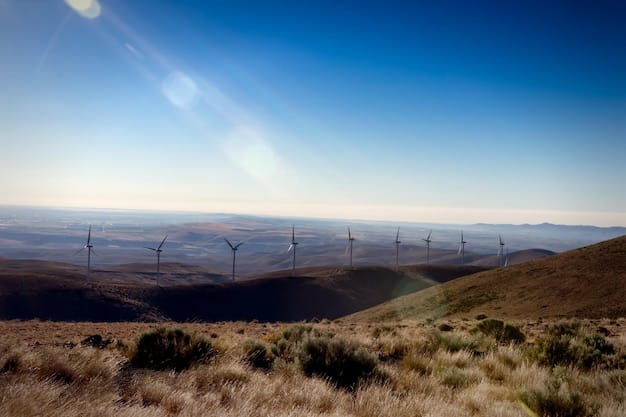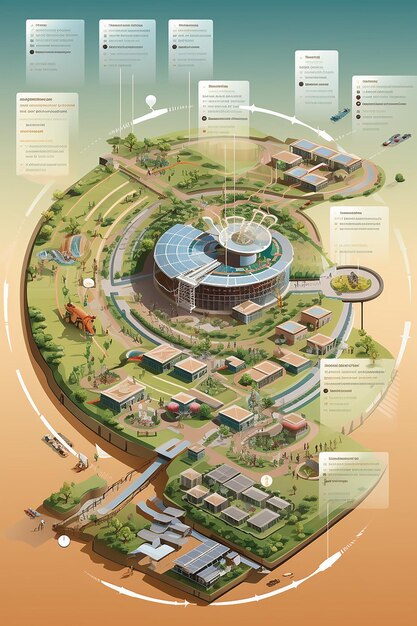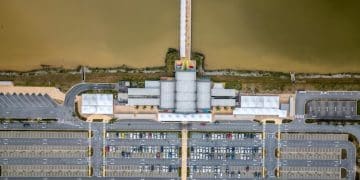Mexico’s Renewable Energy Sector: Investment Opportunities for US Companies

“`html
Mexico’s Renewable Energy Sector: What Are the Investment Opportunities for US Companies? The Mexican renewable energy sector offers significant investment opportunities for US companies, driven by ambitious government targets, geographical advantages, and a growing demand for sustainable power, despite facing regulatory uncertainties and competition.
Exploring Mexico’s Renewable Energy Sector: What Are the Investment Opportunities for US Companies? reveals a dynamic landscape poised for growth, offering a unique blend of promise and complexity. This sector, while presenting appealing prospects for sustainable development and lucrative returns, also navigates a complex interplay of policy, economics, and environmental ambition. Understanding these nuances is key for US companies considering a strategic entry into this evolving market.
Mexico’s renewable energy landscape: current status and potential
Mexico’s renewable energy landscape is characterized by its vast, untapped potential and a dynamic regulatory environment. The country possesses abundant natural resources, including high solar irradiation, significant wind corridors, and geothermal reserves, making it an ideal candidate for large-scale renewable energy deployment. Despite these inherent advantages, the sector’s development has experienced periods of rapid growth interspersed with policy shifts that have introduced considerable uncertainty for investors.
The Mexican government has historically set ambitious targets for clean energy generation, aiming for a substantial portion of its electricity to come from renewable sources in the coming years. These targets reflect a commitment to diversifying the energy matrix, reducing reliance on fossil fuels, and meeting international climate change commitments. However, the implementation of these goals has often been subject to political priorities, leading to evolving frameworks that require careful navigation by foreign entities. The clean energy certificates (CELs) market, for instance, was designed to incentivize renewable energy projects but has seen its effectiveness fluctuate due to changes in regulatory support.
Geographically, Mexico’s northern states are particularly rich in solar resources, making them prime locations for photovoltaic projects. The Isthmus of Tehuantepec is renowned globally for its consistent and strong winds, suitable for large-scale wind farm developments. Additionally, the country’s volcanic regions offer significant geothermal potential, though this resource remains largely undeveloped compared to solar and wind. These diverse resource endowments mean that a wide array of renewable energy technologies can be deployed effectively across the country, catering to different regional needs and investment preferences.
The current energy infrastructure in Mexico is still heavily reliant on conventional sources, predominantly natural gas and fossil fuels. This reliance underscores the urgent need for diversification and modernization, presenting a compelling case for renewable energy investments. The existing transmission infrastructure, however, often presents a bottleneck, as it was not originally designed to integrate large volumes of intermittent renewable energy. This challenge necessitates further investment in grid modernization and expansion to fully realize Mexico’s renewable potential. Addressing grid limitations is one of the critical areas where US expertise and capital can play a transformative role.
Despite the challenges, the underlying demand for electricity in Mexico continues to grow, driven by industrial expansion, urbanization, and a rising middle class. This increasing demand creates a natural market for new power generation capacity, positioning renewable energy as a cost-effective and environmentally friendly solution. Furthermore, many large industrial and commercial consumers are increasingly seeking clean energy solutions to meet their own sustainability goals and reduce operating costs, creating a growing market for private power purchase agreements (PPAs) that bypass some of the complexities of the national grid.
In summary, Mexico’s renewable energy landscape is a complex tableau of immense potential, evolving policies, and infrastructure needs. While the inherent resources and growing demand present a strong pull for investment, understanding and adapting to the regulatory environment and infrastructure constraints are paramount for successful entry into this vibrant sector. The nation’s strategic location, its extensive renewable resources, and its commitment to cleaner energy sources continue to make it an attractive, albeit challenging, frontier for US companies engaged in the green energy transition.
Key investment opportunities for US companies
For US companies eyeing the Mexican renewable energy sector, a multitude of specific investment opportunities present themselves, ranging from utility-scale projects to distributed generation and advanced energy solutions. These opportunities are often best pursued with a deep understanding of local market dynamics and strategic partnerships.
Utility-scale solar and wind projects
The most prominent opportunities lie in utility-scale solar photovoltaic (PV) and wind energy projects. Mexico’s abundant solar irradiation, particularly in the northern states, makes it highly competitive for large PV farms. Similarly, the consistent high winds in regions like Oaxaca offer ideal conditions for wind farms. Investors can participate in these projects through various models, including direct development, acquisition of existing assets, or financing through equity and debt. The appetite for large-scale renewable generation remains high among CFE (Comisión Federal de Electricidad) and private off-takers, although government procurements have seen some changes, shifting focus towards direct bilateral agreements and private initiatives.
- Direct Development: Identifying suitable land, obtaining permits, and constructing power plants from the ground up.
- Asset Acquisition: Purchasing operational or near-completion projects, often offering quicker returns and reduced development risk.
- Private PPAs: Entering into power purchase agreements directly with large industrial consumers looking to source clean energy.
Distributed generation and commercial/industrial (C&I) solutions
Beyond utility-scale, the distributed generation (DG) market, particularly for commercial and industrial (C&I) clients, is experiencing robust growth. Mexican companies are increasingly seeking to reduce their electricity costs and enhance energy security by installing solar panels on their rooftops or within their facilities. This segment is less exposed to some of the larger regulatory shifts affecting the utility-scale market, making it an attractive and more stable investment area for many US companies specializing in localized solutions. Opportunities here include solar installations, battery storage integration, and energy efficiency solutions tailor-made for businesses.
The C&I sector offers a unique proposition for US companies looking for faster payback periods and less bureaucratic hurdles. Many businesses in Mexico are eager to reduce their operating expenses and achieve sustainability targets, making them receptive to innovative energy solutions. This includes not just solar PV, but also solutions for energy management, smart grids within industrial parks, and microgrids that integrate various renewable sources with storage to ensure reliable power supply.
Energy storage and grid modernization
As Mexico integrates more intermittent renewable energy into its grid, the demand for energy storage solutions, particularly battery energy storage systems (BESS), is set to soar. BESS can provide grid stability, peak shaving services, and allow for better utilization of renewable generation. Investment in grid modernization, including smart grid technologies, advanced metering infrastructure (AMI), and transmission line upgrades, also represents a critical need and therefore a significant opportunity. US companies with expertise in these areas can offer crucial technological solutions and project management capabilities. The need for a more resilient and flexible grid is paramount as Mexico moves towards greater renewable energy penetration.
The modernization of the existing grid infrastructure is a massive undertaking, requiring both significant capital and advanced technological know-how. US companies, with their extensive experience in smart grid technologies, energy management systems, and high-voltage transmission, are well-positioned to contribute to this essential transformation. Opportunities exist in engineering, procurement, and construction (EPC) services, as well as in providing the necessary technology and operational expertise. Furthermore, developing solutions that bridge the gap between intermittent renewable supply and constant demand presents a fertile ground for innovation and investment.
In addition to solar, wind, and storage, specialized sectors like geothermal and biomass also offer niche opportunities. While perhaps not as widespread as solar or wind, these technologies can be highly effective in specific regions of Mexico. Geothermal, in particular, could see greater development given Mexico’s volcanic activity, offering a stable base load renewable power source. US companies with specialized expertise in these less common renewable technologies may find unique, high-value opportunities by leveraging their niche capabilities.
In essence, the Mexican renewable energy sector provides a broad spectrum of investment pathways for US companies. From powering entire cities with utility-scale solar and wind farms to providing localized energy independence for businesses through distributed generation, and modernizing the backbone of the energy system with storage and smart grid technologies, the opportunities are diverse and compelling. Success in these ventures will hinge on adaptability, an understanding of the local market, and a willingness to forge effective partnerships.

Navigating regulatory and political landscapes
Navigating the regulatory and political landscapes in Mexico is arguably one of the most critical aspects for US companies considering investment in the renewable energy sector. The policy environment has seen significant changes under recent administrations, introducing a complex and sometimes unpredictable framework for foreign investors. Understanding these shifts and their potential implications is paramount for successful project development and long-term viability.
The current Mexican administration has expressed a preference for strengthening state-owned energy companies, CFE (Comisión Federal de Electricidad) and Pemex (Petróleos Mexicanos), often at the expense of private sector participation, particularly in the electricity generation market. This has led to policy decisions that have been perceived by some as undermining the previous energy reforms that sought to liberalize the market. These changes include, but are not limited to, modifications in grid access rules, permitting processes, and the clean energy certificates (CELs) market. For example, some regulatory adjustments have prioritized dispatch from CFE-owned plants, even if they are less efficient or produce more emissions than private renewable projects.
One of the primary concerns for investors has been the legal uncertainty created by these policy shifts. Several proposed reforms and administrative actions have faced legal challenges, leading to ongoing litigation and a lack of clear precedents. This environment of judicial review means that project developers must not only contend with current regulations but also anticipate potential future changes and their impact on project economics and feasibility. Engaging with legal counsel specializing in Mexican energy law is therefore indispensable for any prospective investor.
Permitting and administrative processes can be protracted and complex, requiring a deep understanding of local, state, and federal requirements. Delays in obtaining environmental impact assessments, land use permits, and grid interconnection agreements can significantly impact project timelines and budgets. Establishing strong relationships with local stakeholders, including government officials, community leaders, and indigenous groups, is crucial for smooth project execution. Social acceptance and community engagement are increasingly important factors in obtaining and maintaining operational permits.
Furthermore, the investment climate is influenced by broader geopolitical considerations and bilateral relations between Mexico and the United States. Trade agreements such as the USMCA (United States-Mexico-Canada Agreement) provide a framework for investment protection, but specific energy sector disputes can still arise. US companies should be aware of avenues for dispute resolution under these agreements, should the need arise. The stability of these bilateral relationships can significantly impact the perception of investment risk in Mexico.
To mitigate these risks, US companies should consider forming strategic alliances with experienced local Mexican partners. These partnerships can provide invaluable insights into the local operating environment, navigate regulatory hurdles, and facilitate community engagement. Local partners can also help in securing favorable land agreements and understanding the nuances of the Mexican labor market. Due diligence, comprehensive risk assessment, and adaptability are key attributes for any US company looking to succeed in this complex, yet promising, market.
In essence, while Mexico offers vast renewable potential, its regulatory and political landscape demands a cautious yet strategic approach. Investors must be prepared for an environment where policy can evolve, legal challenges are possible, and local engagement is paramount. A well-informed strategy, combined with robust local partnerships, can help US companies effectively navigate these complexities and capitalize on Mexico’s renewable energy opportunities.
Financing and incentives for renewable projects
Securing appropriate financing and understanding the available incentives are pivotal steps for US companies looking to invest in Mexico’s renewable energy sector. The financing landscape is diverse, often requiring a blend of international and local capital, while incentives, though sometimes shifting, can significantly impact project viability and returns.
International development banks, multilateral financial institutions, and export credit agencies often play a crucial role in de-risking renewable energy projects in emerging markets like Mexico. Institutions such as the Inter-American Development Bank (IDB), World Bank, and the US International Development Finance Corporation (DFC) provide various forms of financing, including loans, guarantees, and political risk insurance. These organizations can offer more favorable terms than commercial lenders, especially for projects contributing to sustainable development and meeting specific social and environmental criteria. For US companies, DFC specifically aims to support US foreign policy and development goals, making it a relevant partner.
Commercial banks, both international and Mexican, also participate in project financing, though their terms might reflect perceived risks in the market. Foreign investors might find it beneficial to work with Mexican banks that have a strong understanding of local regulations and are more accustomed to financing renewable projects within the national context. The syndicated loan market can also be an option for larger projects, pooling resources from multiple financial institutions to provide the required capital. Equity financing, from private equity funds, infrastructure funds, and corporate investors, remains a cornerstone for project development.
On the incentives front, Mexico historically relied on mechanisms such as Clean Energy Certificates (CELs) to promote renewable energy. CELs are tradable instruments that verifiy the production of a certain amount of clean energy, creating a market-based incentive for clean power generation. While the legal framework for CELs remains, their practical implementation and market liquidity have been affected by regulatory changes that have expanded the pool of eligible generation sources, potentially reducing their value. Investors must therefore conduct thorough due diligence on the current and projected value of CELs for their specific projects.
Tax incentives can also play a role, although these generally vary and are often less specifically tailored to renewable energy than in some other countries. Depreciation allowances for new equipment, for instance, can indirectly benefit renewable projects by reducing the tax burden. Investors should consult with local tax experts to fully understand the applicable tax regime and any potential benefits.
Beyond direct financial incentives, the growing demand from corporate off-takers for clean energy through Power Purchase Agreements (PPAs) acts as a powerful market driver. Companies striving for sustainability, or seeking to hedge against volatile electricity prices, are increasingly willing to sign long-term PPAs with renewable energy developers. These PPAs provide a stable revenue stream for projects, making them more attractive to financiers and reducing market risk. For US companies, this trend presents an opportunity to develop projects specifically for corporate clients, sometimes bypassing the complexities of the national utility grid.
Furthermore, state and local governments sometimes offer specific incentives or streamlined permitting processes for investments that bring jobs and economic development to their regions. Engaging with local economic development agencies can uncover these localized benefits. Understanding the nuances of Mexico’s energy policy and regulatory changes is crucial for investors. Risk mitigation strategies, such as political risk insurance, currency hedging, and robust legal contracts, should also be part of the financing strategy to protect against potential future policy shifts or economic volatility.
In conclusion, while Mexico’s renewable energy sector presents attractive investment opportunities, a sophisticated approach to financing and a realistic assessment of incentives are essential. Leveraging international financial institutions, forging partnerships with local banks, and thoroughly evaluating market-driven demand like corporate PPAs will be key to unlocking the full potential of these investments. Adaptability in financial structuring, alongside a comprehensive understanding of the evolving incentive landscape, will dictate sustained success in this vibrant market.

Challenges and risk mitigation strategies
Investing in Mexico’s renewable energy sector, while promising, is not without its challenges. These can range from regulatory and political shifts to infrastructure limitations and social considerations. Understanding these hurdles and implementing robust risk mitigation strategies are crucial for US companies aiming for long-term success.
Regulatory and policy uncertainty
Perhaps the most significant challenge is the evolving and sometimes unpredictable regulatory and policy environment. Policy changes have led to legal challenges and delays for projects, creating an uncertain investment climate. The current administration’s emphasis on state-owned entities has introduced complexities, particularly regarding grid access and dispatch priority for private renewable projects. This environment necessitates constant monitoring of policy developments and engaging with legal experts specialized in Mexican energy law to ensure compliance and anticipate potential impacts.
- Mitigation: Conduct rigorous legal and regulatory due diligence. Incorporate flexibility into project development plans to adapt to potential policy shifts. Consider obtaining political risk insurance from institutions like the DFC.
- Mitigation: Engage in proactive communication with relevant government agencies and industry associations to stay informed and advocate for transparent, predictable policies.
Grid infrastructure limitations
Mexico’s existing grid infrastructure was not initially designed to handle the rapid expansion of intermittent renewable energy sources. This can lead to transmission bottlenecks, curtailment of renewable generation, and challenges in grid stability. The lack of sufficient transmission capacity in some high-resource areas can hinder project development and interconnection. Investment in grid upgrades and modernization, though a significant opportunity in itself, is slow and remains a bottleneck for new capacity.
Mitigation: Prioritize projects in areas with existing or planned grid capacity. Explore options for energy storage or hybrid projects to mitigate intermittency. Consider distributed generation projects that can minimize reliance on the national grid. Engage in discussions with CFE and energy regulators regarding grid expansion plans.
Social and environmental considerations
Large-scale renewable projects, particularly wind and solar farms, require significant land areas, which can sometimes lead to social conflicts over land rights, particularly with indigenous communities. Environmental impact assessments and permitting can be lengthy processes, and projects may face opposition from local groups if not properly managed. Ensuring social license to operate is as important as obtaining legal permits.
Mitigation: Implement robust community engagement strategies from the outset of project development. Conduct thorough social and environmental impact assessments, respecting indigenous rights and local customs. Ensure fair land acquisition practices and consider community benefit-sharing programs to foster local support.
Other challenges include competition within the market, which, while healthy, can drive down power prices; currency fluctuations between the US dollar and Mexican peso, impacting project economics; and sometimes, security concerns in certain regions. Each of these requires a tailored approach and continuous monitoring.
Mitigation: For market competition, focus on cost efficiency, technological innovation, and value-added services. For currency risk, consider hedging strategies or structuring contracts in USD where feasible. For security concerns, engage local security consultants and implement robust security protocols adapted to the specific region of operation.
In essence, while Mexico offers compelling opportunities in renewable energy, successful investment hinges on a proactive and comprehensive approach to risk management. This involves meticulous planning, deep understanding of the local context, strong legal and financial structuring, and a commitment to responsible and sustainable development practices. By addressing these challenges head-on, US companies can build resilient and profitable ventures in Mexico’s green energy transition.
Success stories and lessons learned
Examining past success stories and deriving key lessons from ventures in Mexico’s renewable energy sector offers invaluable insights for prospective US investors. These narratives highlight the effectiveness of strategic partnerships, adaptability, and a long-term vision in navigating the market’s complexities.
One notable success story involves a large US utility-scale solar developer that successfully brought several significant projects online in northern Mexico. Their success can be largely attributed to their early entry into the market during a period of more favorable regulatory conditions and their ability to secure long-term Power Purchase Agreements (PPAs) with both CFE and private off-takers. A key lesson learned from their experience is the importance of having a robust and highly experienced local team. This team was instrumental in navigating the intricacies of Mexican permitting, local community relations, and understanding the nuances of the energy market reforms as they evolved. They also prioritized advanced solar technology, ensuring high efficiency and competitive electricity generation costs.
Another compelling example comes from the wind energy sector, where a US-Mexican joint venture developed and operates a significant wind farm in the Isthmus of Tehuantepec. Their success was partly due to their deep commitment to community engagement and social responsibility from the project’s inception. They invested heavily in local infrastructure improvements, provided educational programs, and established clear mechanisms for community dialogue and benefit sharing. This proactive approach significantly mitigated potential land disputes and social opposition, allowing for smoother project execution and sustained operational stability. The lesson here is that building trust and delivering tangible benefits to local communities is not just good practice, but a critical component of project de-risking and long-term viability in Mexico.
In the distributed generation (DG) space, a US firm specializing in rooftop solar installations for commercial and industrial clients has seen steady growth. Their success is rooted in a business model that is less reliant on large-scale government auctions and more on direct customer relationships. They focused on providing compelling value propositions to businesses, including lower electricity bills, energy independence, and sustainability credentials. A key lesson from their journey is the importance of clear, flexible financing options for clients and developing standardized, efficient installation processes. They found that building a strong network of local sales and installation partners was crucial for scaling their operations effectively across different regions of Mexico.
Conversely, lessons can also be drawn from projects that faced significant hurdles or delays. Some investors learned the hard way about the critical importance of exhaustive due diligence on land tenure and legal frameworks, particularly concerning indigenous lands. Others faced setbacks due to underestimating the time and resources required for regulatory approvals and grid interconnection. These experiences underscore the need for realistic timelines, conservative financial modeling, and having contingency plans for potential delays or unexpected policy shifts.
A recurring theme across successful ventures is adaptability. The Mexican energy market is dynamic, and investors who are willing to adjust their strategies, embrace new technologies, and respond proactively to political and economic changes are more likely to thrive. This includes being open to different financing structures, exploring new off-take models (like corporate PPAs), and continuously optimizing operations.
In summation, the success stories in Mexico’s renewable sector highlight several critical factors: deep local understanding, strong community relations, robust legal and regulatory due diligence, adaptable business models, and strategic partnerships. For US companies, integrating these lessons into their investment strategy can significantly enhance their prospects for fruitful and sustainable engagement in Mexico’s thriving green energy transition.
Future outlook and strategic considerations
The future outlook for Mexico’s renewable energy sector, while facing current headwinds from policy shifts, remains fundamentally strong due to underlying economic drivers and environmental imperatives. For US companies, developing a strategic vision that accounts for both the opportunities and obstacles is paramount for long-term success.
Despite recent governmental rhetoric and actions favoring state-owned energy companies, the long-term trends suggest a continued, albeit perhaps slower, transition towards cleaner energy. Mexico’s international commitments under climate agreements, coupled with the increasing cost-effectiveness of renewable technologies, will inevitably push for greater adoption. Furthermore, the burgeoning demand for electricity, driven by population growth and industrial expansion, necessitates new generation capacity, which renewables can often supply more cheaply and quickly than new thermal plants, especially natural gas which often relies on international supply chains and price volatility.
One key strategic consideration for US companies is to diversify their investment focus beyond traditional utility-scale projects, particularly given the current regulatory climate that has made such projects more challenging to develop. The commercial and industrial (C&I) distributed generation market, for example, is less susceptible to federal policy fluctuations and is driven directly by end-user demand for cost savings and sustainability. Investing in energy efficiency, microgrids, and localized storage solutions for businesses and industrial parks presents a more stable and growing segment.
Another critical strategy involves an emphasis on technological innovation and value-added services. As the market matures, simply offering commodity renewable energy may become less competitive. US companies can differentiate themselves by bringing advanced technologies such as smart grid solutions, sophisticated energy management systems, and innovative financing models (e.g., energy-as-a-service or performance-based contracts). Expertise in integrating renewable energy with battery storage, for example, will be increasingly valuable as the grid demands greater flexibility and reliability.
Building strong, trust-based relationships with local stakeholders is also a non-negotiable strategic imperative. This extends beyond government officials to include local communities, indigenous groups, environmental organizations, and local business partners. A genuine commitment to social responsibility and sustainable development, which includes creating local jobs, respecting land rights, and contributing to community welfare, can significantly de-risk projects and build long-term goodwill.
US companies should also closely monitor the political landscape, both in Mexico and within the context of US-Mexico bilateral relations. While the USMCA provides a framework for trade and investment, specific energy disputes can influence investor confidence. Staying informed and being prepared to navigate potential challenges through diplomatic or legal channels is part of a robust strategic plan. Diversifying geographic locations within Mexico can also mitigate risks; some states are more proactive and transparent in supporting renewable projects than others.
The increasing focus on ESG (Environmental, Social, and Governance) criteria by international investors and financial institutions will also shape the future. Projects that demonstrate strong ESG performance are more likely to attract capital and receive favorable terms. US companies, often leaders in ESG practices, can leverage this aspect as a competitive advantage in Mexico.
In conclusion, while the Mexican renewable energy sector’s path may have twists and turns, its fundamental growth trajectory remains positive. US companies best positioned for success will be those that are adaptable, innovative, committed to local partnerships, and pragmatic in their approach to risk. By focusing on diversified opportunities, leveraging technological expertise, and building strong relationships, US investors can play a significant role in Mexico’s energy transition while achieving sustainable and profitable returns.
Partnerships and supply chain considerations
Establishing robust partnerships and strategically managing supply chain considerations are pivotal for US companies seeking to invest successfully in Mexico’s renewable energy sector. These elements not only mitigate risks but also enhance operational efficiency and market access, addressing both local content requirements and logistical challenges.
The power of local partnerships
Partnering with experienced Mexican companies offers numerous advantages. Local partners possess invaluable insights into the regulatory framework, administrative procedures, and cultural nuances of doing business in Mexico. They often have established relationships with government agencies, private landowners, and local communities, which can significantly expedite permitting processes and mitigate social risks. Such alliances can take various forms, from joint ventures for project development to local service agreements for construction, operations, and maintenance (O&M).
A successful partnership goes beyond legal agreements; it requires alignment on vision, values, and risk tolerance. US companies should conduct thorough due diligence on potential partners, including their financial stability, track record, and commitment to ethical business practices. Beyond project development, partnerships can also extend to local engineering firms, legal consultants, environmental specialists, and financial advisors, all of whom contribute to a project’s seamless execution and compliance, ensuring that local expertise guides the project through every stage.
Furthermore, local partnerships can help in meeting any potential “local content” requirements or simply facilitate the integration into the local economy, which is increasingly important for government and community acceptance. They provide access to local labor pools, contractors, and suppliers, which can lead to cost efficiencies and foster strong community relations. Integrating local expertise often translates into more effectively tailored solutions that fit the specific needs and conditions of the Mexican market.
Navigating the supply chain
The supply chain for renewable energy components, especially for solar panels, wind turbines, and battery storage systems, is global. However, strategic management of this supply chain becomes crucial in Mexico due to logistics, import duties, and the desire for efficiency. Many components are imported, often from Asia, impacting project timelines and costs. US companies can leverage their existing global supply networks but must also consider establishing more localized sourcing or assembly operations within North America to benefit from regional trade agreements like USMCA.
The USMCA provides preferential treatment for goods originating in North America, which could incentivize the development of regional supply chains for renewable energy components. While the Mexican manufacturing base for sophisticated components like high-efficiency solar cells or large wind turbine blades is still developing, there are opportunities for manufacturing less complex components or for assembly plants. This could reduce lead times, mitigate tariff risks, and potentially lower overall project costs by optimizing logistics. For instance, manufacturing towers for wind turbines or frames for solar panels within Mexico could present a cost-effective and strategic move.
Logistics and infrastructure within Mexico are another key consideration. Efficient transportation routes from ports of entry to project sites are essential. Understanding the local customs processes, warehousing options, and domestic transportation networks is critical to avoid delays and unexpected costs. Some regions might have less developed infrastructure, requiring more planning and potentially higher logistics costs for component delivery and distribution.
Diversifying suppliers and maintaining strong relationships with them can also help mitigate risks associated with geopolitical events or global supply chain disruptions. Furthermore, ensuring that suppliers adhere to ethical and sustainable practices aligns with broader ESG objectives and can enhance a project’s social license to operate. The reliability of spare parts and O&M services is another vital supply chain consideration, ensuring long-term operational efficiency and minimizing downtime.
In essence, successful investment in Mexico’s renewable energy sector extends beyond securing attractive projects; it requires a holistic approach to building a reliable ecosystem. Strategic local partnerships provide indispensable market insights and facilitate smooth project execution, while meticulous supply chain management ensures cost-efficiency, timely delivery, and operational resilience. By prioritizing these elements, US companies can significantly bolster their competitive position and long-term viability in the dynamic Mexican renewable energy market.
| Key Opportunity | Brief Description |
|---|---|
| ☀️ Solar & Wind Projects | Significant potential in utility-scale and C&I projects due to abundant resources and demand. |
| 🔋 Energy Storage | Growing demand for battery solutions to support grid stability and renewable integration. |
| 🌐 Grid Modernization | Investment needed for smart grid technologies and transmission line upgrades. |
| 🤝 Local Partnerships | Crucial for navigating regulations, community relations, and local market access. |
Frequently asked questions
▼
Mexico boasts abundant solar and wind resources, especially in its northern and southern regions respectively. Solar irradiation levels are among the highest globally, making it ideal for PV projects. The Isthmus of Tehuantepec is internationally recognized for its strong, consistent winds, perfect for large-scale wind farms. Geothermal energy also has significant potential in volcanic areas, though it’s less developed compared to solar and wind.
▼
The primary risks include regulatory and policy uncertainty, particularly shifts that favor state-owned utilities over private players. Grid infrastructure limitations, such as transmission bottlenecks, can also pose challenges. Additionally, social and environmental considerations, including land disputes and community opposition, require careful management. Currency fluctuations and market competition are also factors investors should consider.
▼
Risk mitigation strategies include conducting rigorous legal and regulatory due diligence, forming strategic alliances with experienced local partners, and engaging in proactive community relations. Diversifying investment focuses, such as exploring distributed generation, can reduce exposure to utility-scale market volatility. Utilizing political risk insurance and having flexible project plans are also crucial for success.
▼
Yes, financing opportunities exist through international development banks (e.g., IDB, DFC), commercial banks (both international and Mexican), and private equity/infrastructure funds. Corporate Power Purchase Agreements (PPAs) with large commercial and industrial off-takers are increasingly common, providing stable revenue streams. While Clean Energy Certificates (CELs) exist, their market viability requires careful assessment due to policy changes.
▼
Despite recent policy challenges, Mexico’s renewable energy sector has strong long-term fundamentals due to robust demand, vast natural resources, and international climate commitments. The increasing cost-effectiveness of renewables also supports their growth. While the pace might fluctuate with policy, the underlying economic and environmental drivers will continue to push for greater adoption of clean energy over time.
Conclusion
Mexico’s Renewable Energy Sector: What Are the Investment Opportunities for US Companies? The journey into Mexico’s renewable energy sector for US companies is one of compelling potential tempered by inherent complexities. While the country’s abundant natural resources and burgeoning energy demand present a fertile ground for green investments, navigating the evolving regulatory landscape, infrastructure challenges, and local dynamics requires a nuanced and well-informed approach. Successful ventures are typically characterized by robust due diligence, strategic local partnerships, agile adaptation to policy shifts, and a deep commitment to sustainable and community-inclusive practices. Despite the complexities, Mexico remains a vital market for renewable energy expansion, offering significant returns for those prepared to embark on this dynamic and transformative path. The energy transition is a global imperative, and Mexico’s role within it, though sometimes convoluted, is undeniably crucial, presenting enduring opportunities for discerning US investors.





